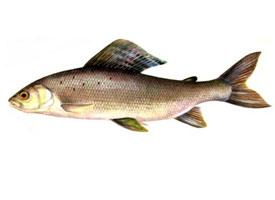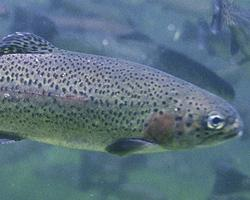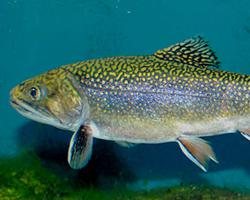
Poids et mesures
| Longueur | de 35 à 60 cm |
|---|---|
| Poids | de 0,3 à 0,4 kg |
Données biologiques
| Durée de vie | 12 r |
|---|
Description de l'animal
The Grayling (Thymallus thymallus) is a fascinating species of freshwater fish, belonging to the salmon family Salmonidae. This species is widely recognized for its unique physical appearance and intriguing behavioral traits. Native to the cold, clear rivers and lakes of Europe and parts of Asia, the Grayling has adapted remarkably to its environment, showcasing a number of features that distinguish it from other freshwater fish.One of the most striking features of the Grayling is its large and sail-like dorsal fin, which is beautifully adorned with iridescent colors that can range from purplish to greenish hues, depending on the light. This fin is not just a spectacle but serves as a stabilizing mechanism when the fish swims against the current. The body of the Grayling is elongated and somewhat flattened on the sides, allowing it to navigate swiftly through its aquatic habitat. Typically, its coloration is a subtle blend of silvery gray with a hint of blue or lavender, camouflaging it effectively against predators.
The Grayling can reach a considerable size, with some specimens growing up to 60 cm (24 inches) in length and weighing as much as 6 kg (13 lbs), although more commonly, individuals are much smaller. Its diet primarily consists of invertebrates, including insects, larvae, and crustaceans, which it forages for within the riverbeds and streams where it resides.
Notably, the Grayling has a keen sense of smell, attributed to its thymus gland, which is unusually large and gives the fish a distinctive thyme-like odor, especially noticeable when freshly caught. This unique characteristic is actually the origin of its scientific name, Thymallus thymallus.
Reproduction for the Grayling occurs in the spring, when water temperatures rise. Unlike salmon, which may travel vast distances to spawn, Graylings tend to spawn in the same rivers or streams where they live. The females lay thousands of tiny eggs in gravelly or sandy bottoms, where the males then fertilize them. The survival of these eggs, and subsequently the fry, is highly dependent on the cleanliness and oxygenation of the water, making the Grayling an indicator species for the health of freshwater ecosystems.
Graylings are known for their shy and elusive nature, making them a prized catch among anglers. They are admired not only for their beauty but also for their spirited fight when hooked, often leaping out of the water. Fly fishing for Grayling is particularly popular, with fishermen using artificial flies that mimic the insects in their natural diet.
Despite their allure, Graylings face several threats, including pollution, habitat destruction, and the impacts of climate change, which can alter the temperature and flow of their freshwater habitats. Conservation efforts are crucial to ensure the survival of this species, emphasizing the importance of maintaining clean and healthy river ecosystems.
In summary, the Grayling (Thymallus thymallus) is a remarkable species, distinguished by its striking dorsal fin, subtle beauty, and fascinating behaviors. It plays a significant role in its ecosystem, both as a predator of invertebrates and as a target for larger predators, including humans. As such, it serves as a reminder of the delicate balance within freshwater habitats and the importance of conservation efforts to preserve these environments for future generations.
Animaux similaires
Nouvelles photos d'animaux
Top 10 des animaux
- Dolphin gull (Leucophaeus scoresbii)
- Japanese macaque (Macaca fuscata)
- Stone loach (Barbatula barbatula)
- Greek tortoise (Testudo graeca)
- Russian tortoise (Testudo horsfieldii)
- Galápagos tortoise (Geochelone nigra complex)
- Diana monkey (Cercopithecus diana)
- Moustached guenon (Cercopithecus cephus)
- Common flying dragon (Draco volans)
- Galápagos penguin (Spheniscus mendiculus)


